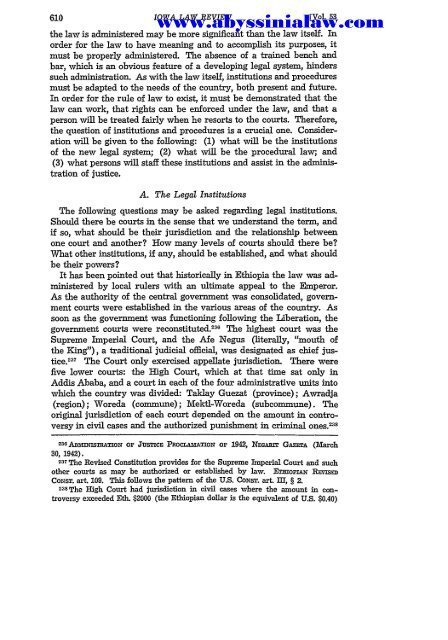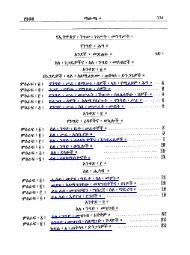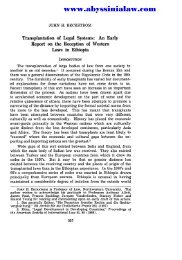Create successful ePaper yourself
Turn your PDF publications into a flip-book with our unique Google optimized e-Paper software.
IOWA LAW REVIEW<br />
[Vol. 53<br />
www.abyssinialaw.com<br />
the law is administered may be more significant than the law itself. In<br />
order for the law to have meaning and to accomplish its purposes, it<br />
must be properly administered. The absence of a trained bench and<br />
bar, which is an obvious feature of a developing legal system, hinders<br />
such administration. As with the law itself, institutions and procedures<br />
must be adapted to the needs of the country, both present and future.<br />
In order for the rule of law to exist, it must be demonstrated that the<br />
law can work, that rights can be enforced under the law, and that a<br />
person will be treated fairly when he resorts to the courts. Therefore,<br />
the question of institutions and procedures is a crucial one. Consideration<br />
will be given to the following: (1) what will be the institutions<br />
of the new legal system; (2) what will be the procedural law; and<br />
(3) what persons will staff these institutions and assist in the administration<br />
of justice.<br />
A. The Legal Institutions<br />
The following questions may be asked regarding legal institutions.<br />
Should there be courts in the sense that we understand the term, and<br />
if so, what should be their jurisdiction and the relationship between<br />
one court and another? How many levels of courts should there be?<br />
What other institutions, if any, should be established, and what should<br />
be their powers?<br />
It has been pointed out that historically in Ethiopia the law was administered<br />
by local rulers with an ultimate appeal to the Emperor.<br />
As the authority of the central government was consolidated, government<br />
courts were established in the various areas of the country. As<br />
soon as the government was functioning following the Liberation, the<br />
government courts were reconstituted.236 The highest court was the<br />
Supreme Imperial Court, and the Afe Negus (literally, "mouth of<br />
the King"), a traditional judicial official, was designated as chief justice.<br />
2 37 The Court only exercised appellate jurisdiction. There were<br />
five lower courts: the High Court, which at that time sat only in<br />
Addis Ababa, and a court in each of the four administrative units into<br />
which the country was divided: Taklay Guezat (province); Awradja<br />
(region); Woreda (commune); Mektl-Woreda (subcommune). The<br />
original jurisdiction of each court depended on the amount in controversy<br />
in civil cases and the authorized punishment in criminal ones. 238<br />
236 ADDImISTRATION OF JUSIC IPROCLAATioN OF 1942, NEGARIT GAZzrA (March<br />
30, 1942).<br />
237 The Revised Constitution provides for the Supreme Imperial Court and such<br />
other courts as may be authorized or established by law. ET aopi=i REVnsED<br />
CoNsT. art. 109. This follows the pattern of the U.S. CoNST. art. I, § 2.<br />
238The High Court had jurisdiction in civil cases where the amount in controversy<br />
exceeded Eth. $2000 (the Ethiopian dollar is the equivalent of U.S. $0.40)





